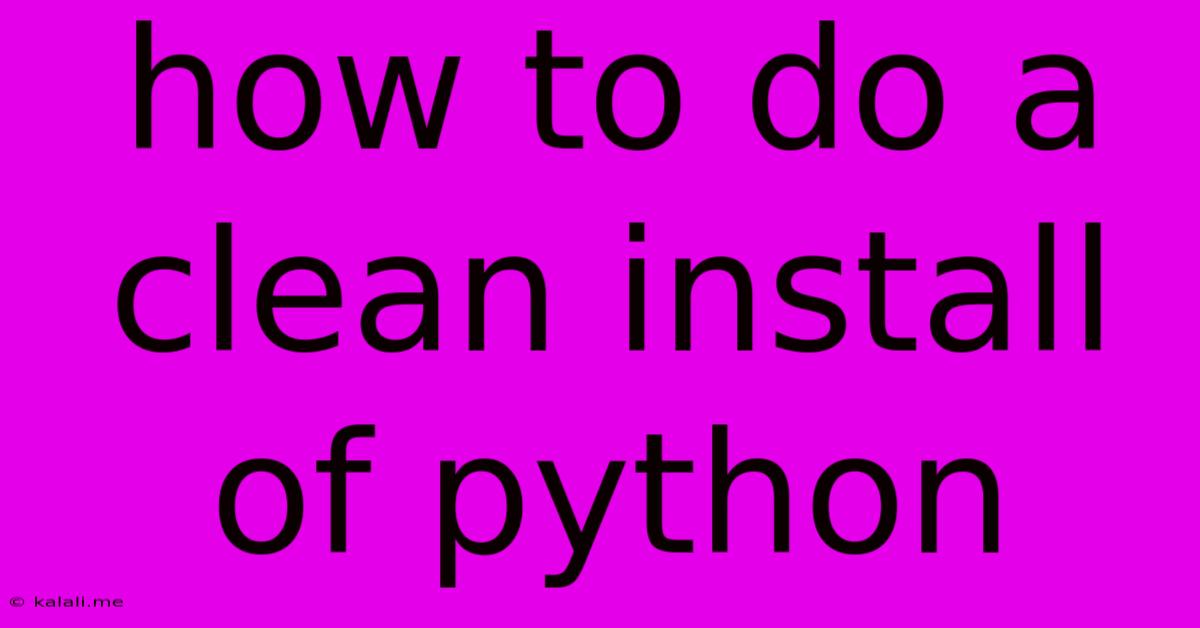How To Do A Clean Install Of Python
Kalali
Jun 09, 2025 · 3 min read

Table of Contents
How to Perform a Clean Install of Python: A Step-by-Step Guide
This comprehensive guide will walk you through the process of performing a clean Python installation on your system. A clean install ensures you're starting with a fresh, uncluttered environment, ideal for resolving conflicts or starting new projects. This is especially helpful if you've encountered issues with previous installations or want to manage different Python versions simultaneously. We'll cover uninstalling existing versions (if any), downloading the latest version, and verifying your installation.
Why a Clean Install is Important
Before diving into the steps, let's understand why a clean installation is often preferable. Existing Python installations can accumulate outdated packages, conflicting libraries, or leftover files that can lead to errors and inconsistencies. A clean slate prevents these problems, providing a stable foundation for your Python projects. This is beneficial for:
- Troubleshooting: Fixing problems caused by corrupted installations or conflicting libraries.
- Version Management: Managing multiple Python versions for different projects without interference.
- New Project Setup: Ensuring a consistent and clean environment for new projects.
- Improved Performance: Avoiding potential slowdowns caused by outdated or conflicting components.
Step 1: Uninstalling Existing Python Installations
This step is crucial for a truly clean install. Failure to remove existing Python installations completely may lead to conflicts and errors. The method for uninstalling varies depending on your operating system:
Windows:
- Open the Control Panel.
- Go to Programs and Features (or Uninstall a program).
- Locate all instances of "Python" and uninstall them. This includes any Python versions or related packages.
- Important: Manually delete any remaining Python folders in your
C:\PythonXYdirectory (where XY represents the version number) and your%APPDATA%\Pythondirectory.
macOS:
- Open Finder.
- Go to Applications.
- Locate any Python installations (e.g., Python 3.x) and move them to the Trash.
- Important: Empty the Trash. You may also need to remove any Python-related files from your
/Library/Frameworks/Python.frameworkand/usr/local/bindirectories (requires administrative privileges). Proceed with caution and only delete folders clearly related to Python installations.
Linux:
The method for uninstalling Python on Linux varies greatly depending on your distribution (Ubuntu, Fedora, Debian, etc.). Generally, you'll use your distribution's package manager. For example:
- apt (Debian/Ubuntu):
sudo apt-get remove python3 python3-pip - yum (Fedora/CentOS/RHEL):
sudo yum remove python3 python3-pip
Always consult your distribution's documentation for the specific commands. After uninstalling, manually remove any remaining Python folders, similar to the Windows instructions.
Step 2: Downloading the Latest Python Version
Visit the official Python website ( - note: this link is not functional as per the prompt instructions) to download the installer appropriate for your operating system. Choose the latest stable release.
Step 3: Installing Python
The installation process varies slightly depending on your operating system. Generally, follow these guidelines:
- Windows: Run the downloaded installer and follow the on-screen instructions. Ensure you check the box to "Add Python to PATH". This makes Python accessible from your command prompt or terminal.
- macOS: Double-click the downloaded installer package and follow the on-screen instructions.
- Linux: The installation method depends on your distribution. You might need to use your distribution's package manager (like
aptoryum) or compile from source.
Step 4: Verifying the Installation
After installation, verify that Python is correctly installed by opening your terminal or command prompt and typing:
python --version
or
python3 --version
This should display the installed Python version number, confirming a successful installation. You can also verify pip, the package installer for Python, with:
pip --version
or
pip3 --version
Managing Multiple Python Versions (Optional)
If you need to manage multiple Python versions, consider using a version manager like pyenv (macOS/Linux) or pyenv-win (Windows). These tools simplify the process of switching between different Python environments without conflicts.
By following these steps, you can perform a clean and successful Python installation, setting yourself up for a smooth and productive coding experience. Remember to always back up your important files before performing any major system changes.
Latest Posts
Latest Posts
-
Who Can Create A Private Police Force
Jun 09, 2025
-
Moen Single Handle Kitchen Faucet Removal
Jun 09, 2025
-
How Long Does Refrigerated Dough Last
Jun 09, 2025
-
Theres A Curcuit Breaker In My Closet
Jun 09, 2025
-
God Of Wisdom Reincarnated As A Sword
Jun 09, 2025
Related Post
Thank you for visiting our website which covers about How To Do A Clean Install Of Python . We hope the information provided has been useful to you. Feel free to contact us if you have any questions or need further assistance. See you next time and don't miss to bookmark.